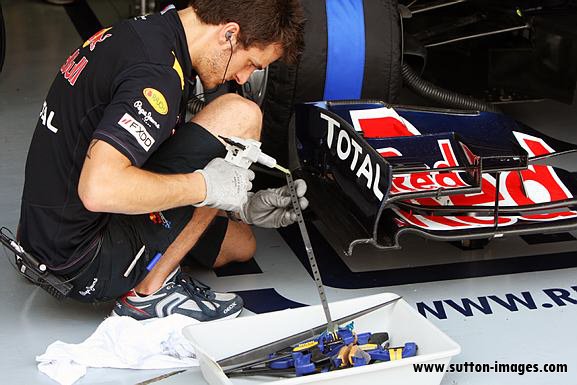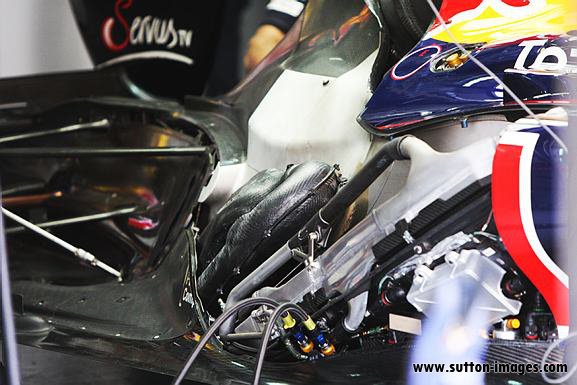
- Login or Register
No account yet? Sign up

you know that that could as well be true :pvolarchico wrote:Adding reinforcement to the underside of the front wing endplates for when they rub on the ground.


I doubt it. Most of carbon fibre composites has large thermal conductivity and low thermal stability compared to both metal (like Inconel) and ceramics (like Zirconia)...the only benefit is a very low weight.n smikle wrote:what in the world? I think it's a clam shell covering of some kind. Similar to what they use on BMW's but it seems to be some ceramic carbon fibre mix, or coating on the inside?

I said clam shell covering. Alot of BMW's have a casing over the exhuast pipes.keoxiv wrote:I doubt it. Most of carbon fibre composites has large thermal conductivity and low thermal stability compared to both metal (like Inconel) and ceramics (like Zirconia)...the only benefit is a very low weight.n smikle wrote:what in the world? I think it's a clam shell covering of some kind. Similar to what they use on BMW's but it seems to be some ceramic carbon fibre mix, or coating on the inside?
Moreover, remember Charlie's quote about "...exhaust pipes are to be made from permitted materials..." - composites are not in the list.

+1.n smikle wrote:I said clam shell covering.keoxiv wrote:I doubt it. Most of carbon fibre composites has large thermal conductivity and low thermal stability compared to both metal (like Inconel) and ceramics (like Zirconia)...the only benefit is a very low weight.n smikle wrote:what in the world? I think it's a clam shell covering of some kind. Similar to what they use on BMW's but it seems to be some ceramic carbon fibre mix, or coating on the inside?
Moreover, remember Charlie's quote about "...exhaust pipes are to be made from permitted materials..." - composites are not in the list.
Yeah, I understood your viewpoint from previous post, but covering metal by a fibre looks weird for me in terms of its physical properties...I said clam shell covering. Alot of BMW's have a casing over the exhuast pipes.

It's called a thermos, and it uses a vacuum to create the insulate property, not an air gap. I'm not sure I see where on the car you think they're using it.Caito wrote:[img]http://www.altrex.com.ar/sp/images/prod ... -1.jpg[img]
This (sorry, couldn't find the english word for it) don't get a hot when I pour nearly boiling water for mate(argentinian tea-like infusion, http://en.wikipedia.org/wiki/Mate_(beverage))
If their is still air between the pipe and the carbon fibre it could be a very good insulation. Still air is "bad" conducting.
Properties of air:
http://www.engineeringtoolbox.com/air-p ... d_156.html
Could have something to do with posted solution..
I think he might be suggesting that they are using a similar principle to keep the hot exhaust from damaging the carbon-fibre bodywork. Granted he didn't quite grasp how a vacuum flask (I don't see a Thermos logobeelsebob wrote:It's called a thermos, and it uses a vacuum to create the insulate property, not an air gap. I'm not sure I see where on the car you think they're using it.Caito wrote:[img]http://www.altrex.com.ar/sp/images/prod ... -1.jpg[img]
This (sorry, couldn't find the english word for it) don't get a hot when I pour nearly boiling water for mate(argentinian tea-like infusion, http://en.wikipedia.org/wiki/Mate_(beverage))
If their is still air between the pipe and the carbon fibre it could be a very good insulation. Still air is "bad" conducting.
Properties of air:
http://www.engineeringtoolbox.com/air-p ... d_156.html
Could have something to do with posted solution..